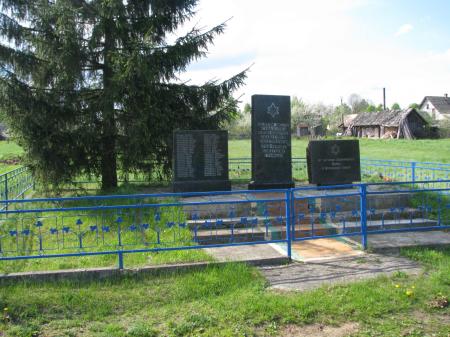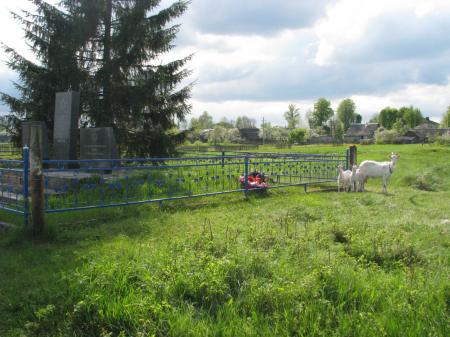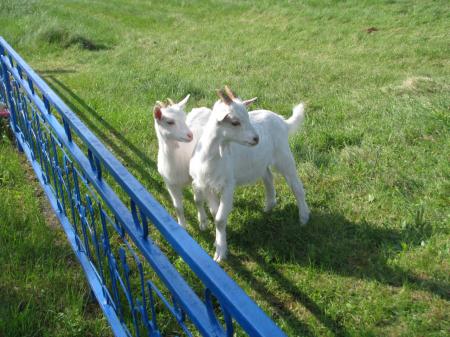Obj. ID: 8347
Jewish Funerary Art Holocaust Monument at the Killing Site in Ilia, Belarus, 1957/1992

Memorial name:
No official name.
Who is Commemorated?
750 Jewish victims of the Holocaust from Ilia.
Description:
The monument is erected at the killing site and the mass grave of the Ilia Jews in the town center, at Revolyutsionaya Street. It consists of three upright steles of different sizes: the right stele was erected in 1957, the central and the left ones in 1992. They all bear Russian inscriptions. In addition, there is Magen David on the central and the left steles.
All steals stand on the podium to which three steps are leading.
The territory of the monument is surrounded by a fence.
Inscriptions:
On the central stele:
In Russian
На этом месте
в 1942 году
немецко-фашистские
захватчики
расстреляли
750 человек
советских
граждан
Translation: At this place, in 1942, 750 Soviet citizens were shot to death by the German-fascist invaders.
On the right stele:
In Russian
[The incomplete list of victims]
On the left stele:
In Russian
От партизан Соломянского
Файвы
и Фогельмана Симхи
Translation: From partisans Solomiansky / Faiva / and Fogelman Simha.
Commissioned by
Probably, the victims' relatives.
sub-set tree:
The Germans entered Ilia on July 3, 1941. In September 1941, a ghetto was established. Since then, several mass actions have taken place [Yad Vashem: The Untold Stories, community].
The action on Revolyutsionnaya Street was carried out on March 17, 1942, when the local auxiliary police assembled at Market Square the Jews of Ilia, took them under guard to an unfinished building for the cold storage of vegetables, located at the beginning of the street not far from the town center, and killed them there [Yad Vashem: The Untold Stories, murder story].
The ghetto was totally liquidated on June 7, 1942 [Yad Vashem: The Untold Stories, community].
After the war the Belarusian Gennadiy Safonov, former deputy commander of the partisan unit "Narodnyi Mstitel" [People's Avenger], who during the war had accepted not a few Jews of Ilja and the vicinity into his unit, succeeded in having the murder site on Revolyutsionnaya Street surrounded by a fence. He also succeeded in having banned the grazing of peasants' cattle at this site. In 1957, also at his initiative, a monument to the Jews murdered in Ilja was erected at the site. The victims' nationallity was not mentioned. However, a six-pointed star was put on the monument, clearly indicating that the victims had been Jews [Yad Vashem: The Untold Stories].
In 1992, again at the initiative of Safonov, and with assistance of his former partisans Simcha Fogelman (who after the war was living in the USA) and Fajwe Solomianski (who after the war was living in Israel under the name Shraga Degani), the monument was enlarged. Two steles were added [Yad Vashem: The Untold Stories].
"Ilja" and "Murder story of Ilja Jews on Revolyutsionaya Street in Ilja,"
Untold Stories - Murder Sites of Jews in Occupied Territories of the USSR (Yad Vashem project), https://collections.yadvashem.org/en/untold-stories/community/14622376, https://collections.yadvashem.org/en/untold-stories/killing-site/14627596.
Tamara Vershitskaya, "Ilia'" in Kholokost na territorii SSSR, ed. Il'ya, Al'tman (Moskva: ROSSPEN, 2011), 348










